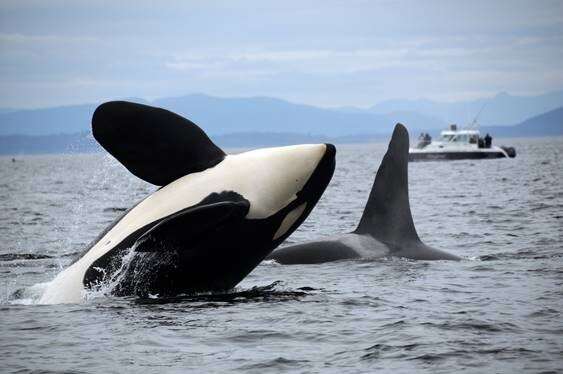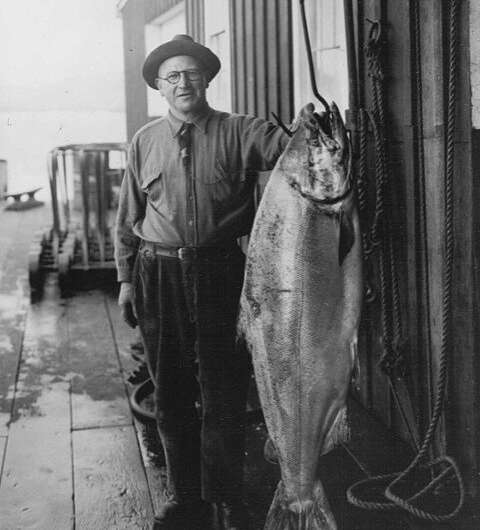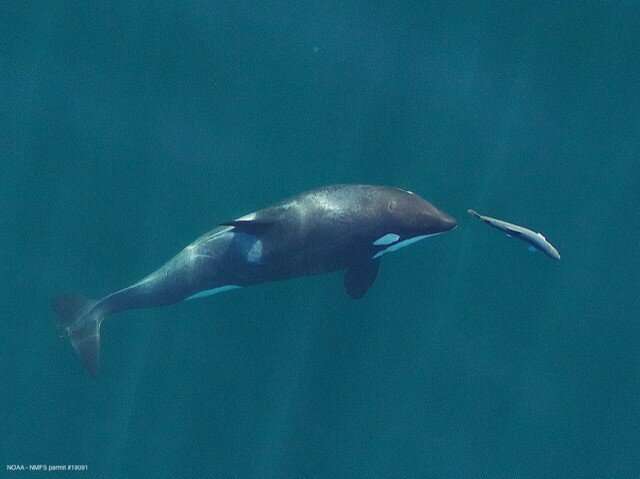Resident orcas' appetite likely reason for decline of big Chinook salmon

Killer whales prefer to eat only the biggest, juiciest Chinook salmon they can find. The larger the fish, the more energy a whale can get for its meal.
Each year these top ocean predators consume more than 2.5 million adult Chinook salmon along the West Coast. Except for the endangered southern resident population in Washington, all other fish-eating orca populations that live along the coast, called "residents," are growing in number. Northern residents along the British Columbia coast number more than 300 whales, for example, while Alaska orcas are close to 2,300 individuals.
But large, old Chinook salmon that orcas crave have mostly disappeared from the West Coast. A new University of Washington and NOAA study points to the recent rise of resident killer whales, and their insatiable appetite for large Chinook salmon, as the main driver behind the decline of the big fish.
The findings were published Dec. 16 in the Proceedings of the National Academy of Sciences.
"We have two protected species, resident killer whales and Chinook salmon, and we are trying to increase abundances of both—yet they are interacting as predator and prey," said lead author Jan Ohlberger, a research scientist at the UW School of Aquatic and Fishery Sciences. "Killer whales don't show a lot of interest in Chinook until they reach a certain size, and then they focus intensely on those individuals."
Chinook salmon are born in freshwater rivers and streams, then migrate to the ocean where they spend most of their lives feeding and growing. Each population's lifestyle in the ocean varies, mainly depending on what stream they were born in and where they can find food. Washington and Oregon fish often migrate thousands of miles north to the Gulf of Alaska where they feed and fatten up before embarking on their migrations back to rivers in the Pacific Northwest to spawn.

As they return south to spawn in their home streams, Pacific Northwest salmon pass through the feeding grounds of several different killer whale populations, which appear to have a keen affinity for big Chinook. It's possible these thriving killer whales are essentially stealing a meal from the southern resident orca population, which is struggling to maintain 73 individuals.
"We like to think of the Pacific Ocean as a really big place, but that's because we are really lousy swimmers. For killer whales and salmon, it's not a big place," said co-author Daniel Schindler, a UW professor of aquatic and fishery sciences. While different orca populations avoid each other in the ocean, they inherently overlap their whole lives when competing for the same prey, he explained.
It used to be common to find Chinook salmon 40 inches or more in length, particularly in the Columbia River or Alaska's Kenai Peninsula and Copper River regions. The average declines in body size—about 10% in length and 25 to 30% in overall weight—could have a long-term impact on the productivity of Chinook salmon populations. Smaller females carry fewer and smaller eggs, so over time the number of fish that hatch and survive to adulthood may decrease.
Resident orcas usually don't go for Chinook until they reach about 25 inches in length, and they really prefer fish that are over 30 inches long, the researchers said.
The research team analyzed nearly 40 years of data from hatchery and wild Chinook populations from California to Alaska, looking broadly at patterns that emerged over the course of four decades and across thousands of miles of coastline. They analyzed whether fishing pressure played a role in why the biggest Chinook have disappeared, and also considered other factors like changing ocean conditions, and feeding from other marine mammals such as sea lions and seals.
While fishing likely played a role in the decline of large Chinook in the past, fishing pressure since the 1970s has been reduced through more stringent fishery regulations. In the same period, resident killer whales have tripled in abundance.

"Something has to be affecting the survival rates of the oldest fish," Schindler said. "It's clear there are lots of unanswered questions, but if you take a weight-of-evidence approach, most arrows are pointing to marine mammals—and killer whales, in particular."
Still, the researchers caution there are many remaining unknowns, such as why there were so many large Chinook in the past. It's possible killer whales have a bigger effect now than they did historically, when there were so many more fish in the ocean, explained co-author Eric Ward, a research scientist at NOAA's Northwest Fisheries Science Center. Declines in the ocean abundance of Chinook salmon as a result of other factors may be intensifying the size-selective effects of orca predation.
"We have seen clear success stories in the rebound of predator species like killer whales," Ward said. "We're trying to understand the suite of tradeoffs we face when we have these increases in predator populations."
The study's findings reflect a North Pacific ecosystem that is fluid and interconnected, and doesn't recognize state and national borders, or their associated management practices.
"This study highlights the fact that local management strategies need to be put in a much broader spatial context," Ohlberger said. "In this case, that means the whole coast, because that's where the fish migrate."
More information: Jan Ohlberger el al., "Resurgence of an apex marine predator and the decline in prey body size," PNAS (2019). www.pnas.org/cgi/doi/10.1073/pnas.1910930116
Journal information: Proceedings of the National Academy of Sciences
Provided by University of Washington



















